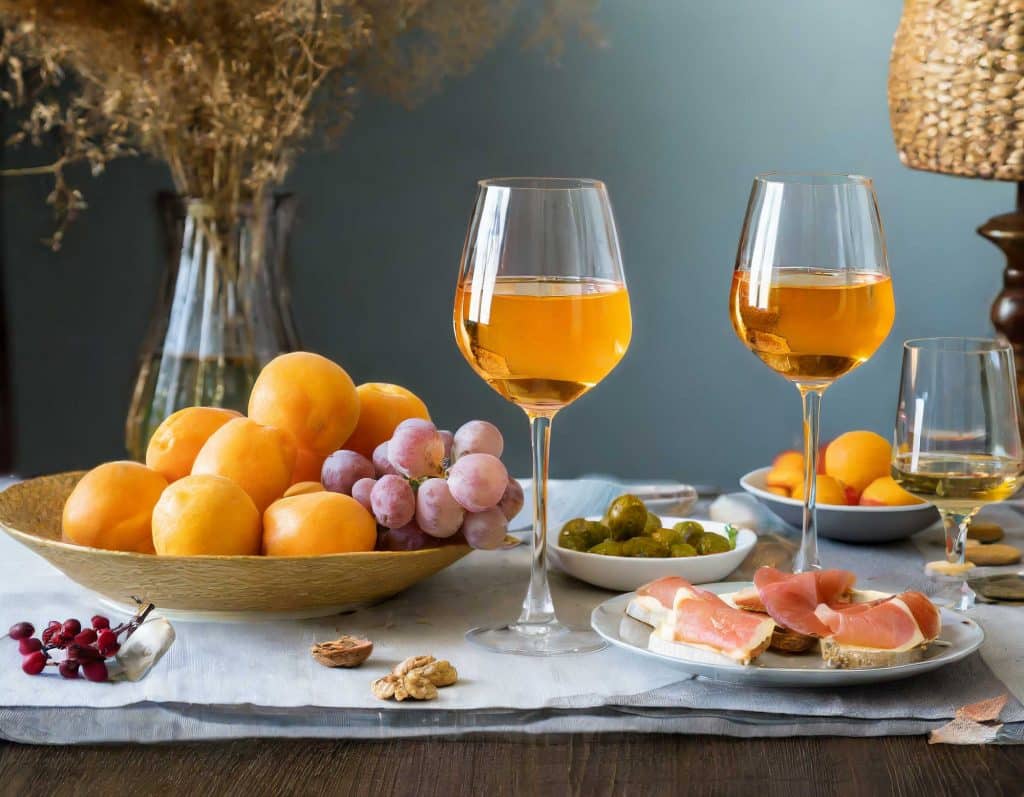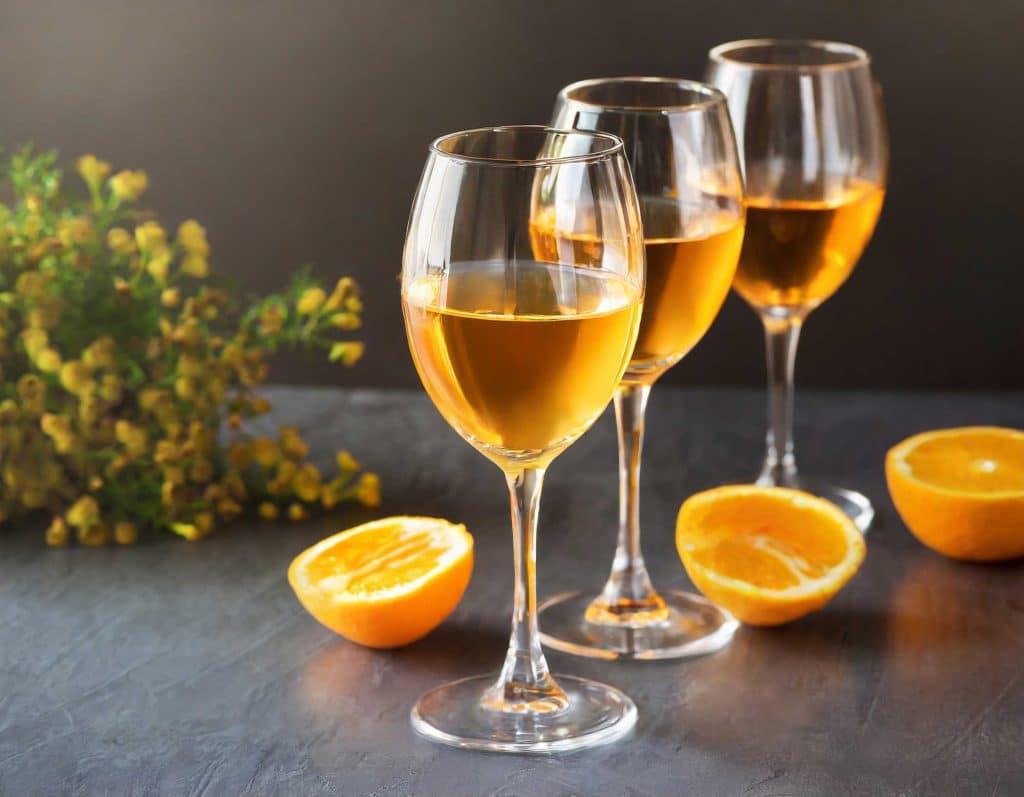Orange wine, often referred to as a skin-contact wine, is a type of wine made from white grape varieties that have been left in contact with their grape skins during fermentation. Unlike the process for white wine, where grape skins are removed, the skins are left to mingle with the grape juice, imparting a unique orange hue to the final product. The practice not only gifts the wine its distinctive colour but also imparts a complexity of flavours and a textural depth that’s more commonly associated with red wines.
Let’s clear up a common misconception: orange wine isn’t made from oranges.
It’s the extended skin contact during the winemaking process that bestows upon it the notable orange or amber tint. This method is a hallmark of ancient winemaking, tracing back thousands of years, predominantly in regions like Georgia and Italy. However, it has found a new lease of life in contemporary vineyards globally, from the rustic landscapes of Slovenia to the fertile wine regions of Australia.
The realm of orange wines is fascinating and diverse. Its spectrum ranges from a pale amber, reminiscent of a setting sun, to a robust, russet orange akin to autumn leaves. The variety in shades is a direct reflection of the grape variety used and the length of skin contact in the winemaking process. While orange wine shares a few similarities with red and white wines, its unique process and resultant taste profile carve out a niche of its own in the wine world. It’s this antique yet innovative wine style that has caught the imagination of modern wine drinkers, providing a rustic bridge between the well-trodden paths of red and white wines.
So, as you venture into the world of orange wines, you’re not just sipping on a glass of wine; you’re partaking in a historical, almost reverential, wine-drinking experience that stretches back to the earliest days of winemaking. Whether you’re a seasoned wine connoisseur or a curious newbie, the realm of orange wine holds a rustic charm and a tantalising mystery waiting to be uncorked.
The Winemaking Process
The making of orange wine is a journey back in time, embracing a traditional winemaking process that’s as old as the hills. It’s a nod to a time when wines were made with minimal intervention, allowing the natural character of the grapes to shine through. Here’s how this golden elixir is crafted:
The process begins with the harvest of white grapes, which are then crushed to release the juice. Unlike white wine, where the grape skins are promptly removed, the making of orange wine involves allowing the grape skins to remain in contact with the juice. This technique, known as “skin contact,” is the heart and soul of orange wine. The duration of this contact can range from a few days to several months, depending on the winemaker’s desired outcome.
The grape juice, along with the skins, seeds, and sometimes stems, is transferred to vessels—often large clay pots or wooden vats—where fermentation kicks off. The yeast present on the grape skins and in the environment initiates the fermentation, transforming the sugar in the grape juice into alcohol. This natural or “wild” fermentation is a hallmark of the organic and biodynamic ethos many orange winemakers adhere to. It’s also what qualifies many orange wines to be termed as natural wines.
As the juice ferments, the skins impart their colour, flavour, and tannins to the liquid, resulting in a wine that combines the freshness and acidity of white wines with the body and tannic structure of reds. This marriage of characteristics is what sets orange wine apart, offering a unique drinking experience that’s both ancient and modern, rustic and refined.
The final step in the winemaking process involves removing the skins and transferring the wine to bottles for ageing. Some orange wines are aged for extended periods, allowing their flavours to mature and evolve, while others are bottled sooner to capture a more youthful, vibrant character.
It’s a process that demands patience and a respect for tradition, yet the result is a wine style that’s thoroughly modern in its appeal. Each sip of orange wine is a toast to the age-old winemaking traditions, blended seamlessly with the innovative spirit of contemporary winemakers keen on exploring beyond the conventional.

The History of Orange Wine
The story of orange wine is as deep and rich as its colour. Its roots stretch back over 5,000 years, making it one of the oldest types of wine in the world. The cradle of orange wine lies in the ancient wine regions of Georgia and Italy, where winemakers of yore discovered the magic that occurs when white grapes are allowed to ferment with their skins.
In Georgia, the tradition of making orange wine has been carried on from generation to generation, preserved through the ebbs and flows of history. The Qvevri, a large egg-shaped clay vessel buried underground, has been the centrepiece of Georgian orange wine production. This ancient vessel allows for a natural fermentation process, where grape juice and skins harmonise under the earth’s steady temperatures, crafting orange wines with a distinct character and a whisper of the wild.
Across the Adriatic Sea, in the northeastern regions of Italy, namely Friuli-Venezia Giulia, the tradition of orange winemaking found a parallel home. Italian winemakers embraced the skin contact method, producing orange wines that became a cherished part of the regional wine heritage.
The journey of orange wine through the ages saw a period of obscurity, overshadowed by the booming popularity of red and white wines. However, the dawn of the 21st century heralded a renaissance for this ancient wine style. Spearheaded by visionary winemakers and bolstered by a growing interest in natural and organic wines, orange wine began to reclaim its rightful place in the wine spectrum.
Now, the amber revolution has spread its wings far beyond the traditional vineyards of Georgia and Italy. Modern-day wine enthusiasts are drawn to the authentic, unadulterated nature of orange wine, making it a symbol of a broader movement towards wines that reflect a sense of place and tradition.
The revival of orange wine is not just a trend, but a testament to the enduring allure of traditional winemaking. It’s a narrative that celebrates the beauty of simplicity, the value of heritage, and the joy of discovery that comes with every bottle uncorked. So, as we delve into the tastes and tales of orange wine, we’re not merely exploring a wine style; we’re embarking on a vinous voyage through time.
What Does Orange Wine Taste Like?
Venturing into the world of orange wine is like embarking on a new taste adventure. This ancient-yet-modern vino offers a kaleidoscope of flavours and aromas that can be both familiar and exotic to your palate. Here’s a little sneak peek into what you can expect when you take that first sip:
The taste of orange wine is as bold as its colour. The longer skin contact infuses the wine with a robust flavour profile, often characterised by notes of bruised apple, hazelnut, and a distinct nutty bitterness. Unlike most white wines, orange wines bring a tannic punch to the table, thanks to the extended grape skin contact. This tannic structure, paired with a zesty acidity, makes orange wine a flavourful journey of discovery with each sip.
The texture of orange wine is another aspect that sets it apart. It possesses a body and mouthfeel more akin to red wines, while still retaining a crisp freshness reminiscent of white wines. The amalgam of these characteristics results in a wine that’s complex yet approachable, rustic yet elegant.
The aroma of orange wine is equally engaging, often exuding scents of dried fruit, orange peel, and an earthy, floral bouquet that invites you in for a taste. It’s a fragrance that hints at the natural, organic process through which the wine is made, often reflecting the very essence of the vineyard it comes from.
Orange wine’s taste can vary widely based on factors like the grape variety used, the length of skin contact, and the winemaking practices employed. Some orange wines are bright and fruity, while others are more complex and savoury. Whether you’re enjoying a glass of a light, aromatic Pinot Grigio-based orange wine or a bold, tannic Sauvignon Blanc variety, the taste adventure is bound to be a memorable one.
The beauty of orange wine lies in its ability to challenge the norms, offering a taste experience that defies categorisation. It invites you to forget the rigid distinctions of red, white, and rosé, and to dive into a unique taste realm where tradition meets modernity. So, the next time you find yourself at a winery or your local wine shop, don’t hesitate to ask for a bottle of orange wine and let your taste buds explore the vibrant spectrum of flavours it has to offer.

Food Pairing with Orange Wines
The vibrant character and bold flavours of orange wines make them stellar companions at the dining table. Their unique profile, straddling the line between red and white wines, offers a versatility that’s hard to beat. Let’s explore some delightful pairings that will elevate your orange wine experience:
Orange wines have a knack for mingling well with a wide range of cuisines. Their robust nature and tannic structure can stand up to hearty meats and spicy dishes, while their inherent acidity and freshness can cut through richer, creamier fare.
Ethnic Cuisines: The bold, aromatic profile of orange wines pairs beautifully with a variety of ethnic cuisines. Whether it’s the spicy kick of Indian curries, the umami richness of Japanese ramen, or the fermented tang of Korean kimchi, orange wine holds its own, complementing and contrasting the flavours in a delightful dance.
Hearty Meats: From grilled sausages to smoked meats, the robustness of orange wines can match the intensity of meaty dishes, making for a balanced and satisfying pairing.
Vegetarian and Vegan Dishes: The earthy, nutty notes of orange wines resonate well with plant-based dishes. Try them with roasted vegetables, hearty grain bowls, or vegan cheese platters for a harmonious pairing.
Cheese: The world of cheese is a playground for orange wine pairings. The wine’s tannic structure and acidity cut through the creaminess of soft cheeses, while its complex aromatics complement the nutty, aged notes of hard cheeses.
Seafood: While it might seem unconventional, the zesty freshness of lighter orange wines can be a delightful match with seafood dishes. Think grilled prawns, seared scallops, or a classic Mediterranean seafood stew.
Poultry and Lighter Meats: The versatility of orange wines shines when paired with poultry and lighter meats. Whether it’s a roasted chicken, duck confit, or a pork tenderloin, orange wine brings a delightful complexity to the table.
The realm of food pairings with orange wine is vast and inviting. It encourages experimentation, urging you to explore beyond the conventional wine and food combinations. So, whether you’re a seasoned foodie or someone just starting to dip your toes into the culinary waters, grab a bottle of orange wine, whip up your favourite meal, and embark on a gastronomic adventure that promises to tantalise your taste buds and broaden your wine horizons.
Popular Grape Varieties for Orange Wine
The world of orange wine is as diverse as the grape varieties that give birth to it. The choice of grape is a pivotal factor that shapes the colour, taste, and aroma of the final product. Let’s wander through some of the popular grape varieties that are the stars of the orange wine stage:
Pinot Grigio: This well-known grape takes on a whole new persona when crafted into an orange wine. The skin contact method extracts more colour from the pinkish-grey skins of Pinot Grigio, often resulting in orange wines with a delightful rose-gold hue and a vibrant aromatic profile.
Sauvignon Blanc: Known for its green and herbaceous flavours, Sauvignon Blanc morphs into a more complex, textured wine with the orange winemaking process. It’s a variety that reveals a different, more adventurous side of itself as an orange wine.
Chardonnay: While Chardonnay is often associated with rich, buttery white wines, its transformation into an orange wine unveils a different character. The extended skin contact introduces a tannic structure and an intriguing complexity, while still retaining some of the grape’s inherent fruitiness.
Ribolla Gialla: A lesser-known grape but a traditional choice for orange winemaking, particularly in the Friuli-Venezia Giulia region of Italy. Ribolla Gialla produces orange wines with a deep amber hue and a rich, nutty flavour profile that’s distinct and memorable.
Gewürztraminer: This aromatic grape variety is a fantastic candidate for orange wine, offering a fragrant bouquet and a spicy palate that is enhanced and nuanced with the skin contact method.
Rkatsiteli: A traditional Georgian grape variety, Rkatsiteli is one of the oldest known grape varieties and a classic choice for orange winemaking. It creates orange wines with a deep, amber colour and a complex, herbaceous flavour profile.
The beauty of orange wine lies in its ability to bring out the untamed, rustic essence of these grape varieties. Each grape contributes its unique personality, painting the canvas of orange wine with a spectrum of colours, tastes, and aromas. As you delve into different orange wines, you’ll discover a fascinating dialogue between the grape, the land it comes from, and the ancient winemaking technique that binds them together. It’s a narrative that’s as engaging to explore as it is to taste.

Buying and Storing Orange Wine
Navigating the orange wine landscape might seem daunting at first, especially with its myriad of styles and expressions. Yet, with a little know-how, you’ll find it’s a journey worth embarking upon. Here’s a guide to buying and storing orange wine to ensure you get the best out of every bottle:
Buying Orange Wine:
Explore Local Wine Shops and Online Retailers: Start your orange wine quest at reputable wine shops or online retailers. Engage with knowledgeable staff or read reviews and descriptions to find a bottle that piques your interest. I found Georgian orange wines on tamada.com.au
Attend Wine Tastings: Wine tastings are an excellent way to explore orange wines. They provide an opportunity to taste different styles and discover what appeals to your palate.
Look for Natural Wine Labels: As orange wine is often produced naturally, look for labels indicating organic or biodynamic practices. It’s a good sign of a winemaker’s commitment to traditional, natural winemaking.
Explore Different Regions: Don’t shy away from trying orange wines from various regions, be it the traditional vineyards of Georgia and Italy or the newer producers in Australia and California. Each region imparts its unique touch to the orange wine it produces.
Storing Orange Wine:
Store Upright: Unlike red wines, it’s advisable to store orange wines upright to minimize oxidation.
Keep in a Cool, Dark Place: Like most wines, orange wine should be stored in a cool, dark place, away from direct sunlight and drastic temperature changes.
Chill Before Serving: Orange wine is best enjoyed slightly chilled. Pop it in the fridge an hour before serving to bring out its refreshing, crisp character.
Don’t Fear the Sediment: Natural orange wines may have some sediment at the bottom of the bottle. It’s a sign of minimal intervention in the winemaking process and is perfectly natural.
Consume Within a Few Days of Opening: Once opened, it’s best to consume orange wine within a few days to enjoy its fresh, vibrant flavours.
Arming yourself with a little knowledge can go a long way in enhancing your orange wine experience. Whether you’re a seasoned wine enthusiast or a newcomer to the wine world, understanding how to buy and store orange wine will ensure you’re well-prepared to dive into the amber waves of this fascinating wine style. So go ahead, explore the shelves, uncork a bottle, and let the orange wine adventure begin!
The Future of Orange Wine
The resurge of orange wine on the global stage is more than just a fleeting trend. It’s a narrative deeply intertwined with the growing appreciation for natural, authentic winemaking practices. As we steer towards a more conscious consumption, the allure of orange wine, with its minimal intervention and organic ethos, seems to resonate with the modern palate. Here’s a glimpse into the promising horizon that lies ahead for orange wine:
Embracing the Natural Wine Movement:
Orange wine has become a flag bearer of the natural wine movement. Its traditional, low-intervention winemaking approach embodies the essence of natural wine – a genuine expression of the grape and the terroir. This alignment with the natural wine ethos is propelling orange wine into the spotlight, earning it a cherished spot among wine enthusiasts who value authenticity and sustainability.
The Amber Revolution:
The ‘Amber Revolution,’ a term coined to describe the burgeoning popularity of orange wine, signifies more than just a growing fondness for this wine style. It’s emblematic of a broader shift towards appreciating wines that are crafted with reverence to age-old traditions. The Amber Revolution is not merely a celebration of orange wine but an ode to the timeless winemaking practices that have stood the test of time.
Broadening the Wine Spectrum:
Orange wine is broadening the spectrum of wine styles, offering a rustic bridge between the familiar territories of red and white wines. Its distinctive character is sparking curiosity, inviting wine lovers to venture beyond the conventional and explore a wine style that’s both ancient and avant-garde.
Global Expansion:
The orange wine movement is no longer confined to its traditional heartlands of Georgia and Italy. Winemakers across the globe, from the rolling vineyards of France to the burgeoning wine regions of Australia and the United States, are embracing the orange winemaking process. This global embrace is not only elevating the status of orange wine but also enriching the orange wine portfolio with a diverse range of expressions.
The trajectory of orange wine is a testament to the enduring allure of authenticity and the human penchant for exploring the roots to understand the present better. As the world of wine continues to evolve, the rustic charm and honest expression of orange wine are poised to captivate the hearts of wine lovers for many more vintages to come. So, as you sip on a glass of orange wine, you’re not just enjoying a delightful drink; you’re partaking in a global narrative that honours the legacy of traditional winemaking while toasting to a promising and exciting future.
With this, we wrap up our exploration into the amber-hued realms of orange wine. It’s been a journey back in time, a toast to tradition, and a nod to the exciting future awaiting this ancient yet contemporary wine style. The world of wine is ever-evolving, and orange wine is a beautiful chapter in this ongoing narrative. So, the next time you come across a bottle of orange wine, don’t hesitate to embrace the adventure it promises, one sip at a time!
FAQ
What is special about orange wine?
Orange wine is unique for its traditional winemaking process, where white grapes are fermented with their skins, imparting a distinctive colour and a complex flavour profile. It’s a celebration of ancient winemaking practices, offering a rustic, authentic wine experience.
Where does it come from?
Traditionally, orange wine hails from the ancient wine regions of Georgia and Italy, where it has been made for over 5,000 years. Today, its production has spread worldwide, with winemakers from regions like Slovenia, Australia, and the United States crafting their versions of this ancient wine style.
What does orange wine taste like?
The taste of orange wine is bold and complex, often featuring notes of bruised apple, nuts, and a certain nutty bitterness. Its flavour profile is enriched by the tannic structure derived from the skin contact, setting it apart from conventional white wines.
Is orange wine sweet or dry?
Most orange wines are dry, with the degree of sweetness varying based on the winemaking process and the grape variety used. The extended skin contact tends to emphasise the tannic and savoury aspects of the wine, often overshadowing any residual sweetness.
Is orange wine just rosé?
No, orange wine is not rosé. While rosé is made from red grapes but with minimal skin contact, orange wine is made from white grapes with extended skin contact. The process gives orange wine its characteristic amber hue and a flavour profile that’s more robust compared to rosé.
Sources
The following sources provided invaluable information that contributed to the richness of this exploration into the world of orange wine:





No Comments